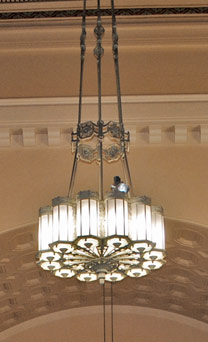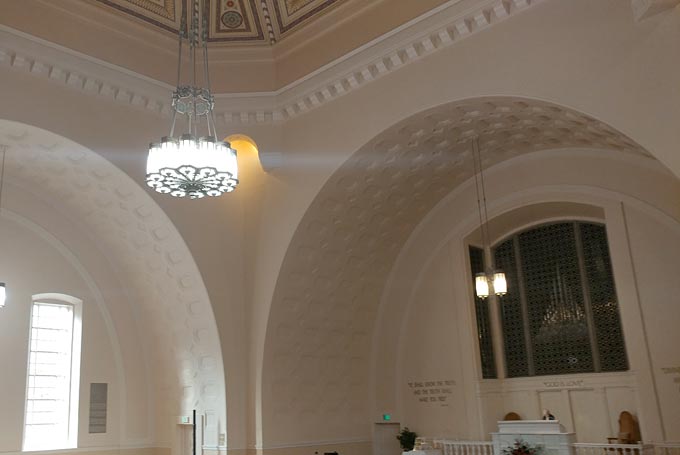A Prayer in Stone:
Historical Facts about Sixth Church
The church’s architectural style has been labeled by experts as Art Deco Byzantine or Early Modern, and was inspired by the 1906 Extension of The First Church of Christ, Scientist, Boston (The Mother Church).

Designed by H. Whitehouse of Morris H. Whitehouse & Associates, Sixth Church was contracted during the worst years of the Great Depression. The congregation, being mindful of how the church was to be a blessing to the community as a whole, considered how the project would be a means of creating economic opportunity for local artisans. Consequently, they instructed the architects to incorporate as much handiwork as possible. The intricate, highly labor-intensive brick-work on the exterior of the Church resulted, as did the hand carving found on the pews. Construction was completed in 1932 at a cost of $350,000.
The interior of the church was restored in 1996. This work included re-painting, re-carpeting, and the much appreciated restoration of the artwork in the center of the auditorium ceiling.
Whitehouse was completing his studies at the Massachusetts Institute of Technology in Boston at the time the Extension was completed (1906) and Sixth Church similarly incorporates Byzantine, classical and modern elements. The auditorium is enclosed by a central octagonal dome surrounded by four barrel vaults arranged in a cruciform plan of a Greek cross. The coffering of the auditorium vaults is reminiscent of the tepidarium (warm room) of the Baths of Caracalla, Rom, while the square and octagonal motifs found in the grillwork and cling design illustrate an eastern influence. The sloping floor and radial seating, while ancient in concept, reflect a modern influence.
Whitehouse was also responsible for designing many other local landmarks, such as the Columbia Gorge Hotel, Temple Beth Israel, the Waverly Golf Course Clubhouse, Portland’s Lincoln and Jefferson high schools, the United States Federal Courthouse Building, and the Oregon State Capitol Building.
Lighting

The interior light fixtures were designed by Frederick Charles Baker, a well-known Oregon lighting designer whose career spanned 68 years. Trained as a draftsman after taking classes from Ellis Lawrence, the Dean of the University of Oregon School of Architecture, Baker started his career in 1910. Three years later he was hired by Henry Pittock to design the chandeliers and other lighting fixtures for the Pittock Mansion. At the end of his career, he left behind over 9,000 drawings of his lighting projects. Frederick Baker also designed lighting for Temple Beth Israel, Meier and Frank’s Georgian Room, the Waverly Country Club, the Multnomah County Library, and Timberline Lodge.
Heating and Cooling
The original air conditioning system used large blocks of ice for cooling the edifice. The air scrubber chamber, located below ground, was filled with blocks of ice. As fan-forced air passed over the ice, it was chilled; then the chilled air was circulated throughout the building. This system of cooling was so effective that members wore jacket-style clothing while attending the services. Over time, the chamber began to leak, and this system of cooling was abandoned. The air scrubber chamber currently plays a part in the church’s cooling system, albeit without the picturesque blocks of ice. The venting system is highly effective and keeps the interior of the church pleasant on the hottest of summer days.
The Organ
Built in 1931 by Austin Organs of Hartford, Connecticut, Sixth Church’s organ is a three manual organ with 33 ranks (or sets) of pipes. It has a total of 1,990 pipes, which range in size from 18 feet to one quarter inch. Thousands of board feet of pine and poplar were used in the construction of the large pipes, wind chests and expression chambers. The metal pipes were made of alloys of lead and tin, zinc, brass and copper.
In 1998 the organ underwent an extensive cleaning to remove dust that had accumulated over the previous seventy years. All the reed pipes were shipped back to the Austin company for restoration. New tongues and tuning scrolls were added and the pipes were washed, stripped and coated with a protective shellac. One week was spent regulating the pipes returning the organ to its original timbre.
Parking
During the church services (Sundays and Wednesdays) and activities such as lectures and business meetings, the parking lot at the corner of 10th Avenue and Columbia Street is made available, free of charge, to participants.







